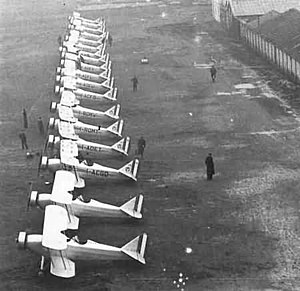| C.5 | |
|---|---|
 | |
| General information | |
| Type | Civil trainer |
| Manufacturer | Costruzioni Aeronautiche Novaresi S.A. (CANSA) |
| Designer | Giacomo Mosso |
| Primary user | Regia Aeronautica |
| Number built | 65 |
| History | |
| First flight | 24 July 1939 |
The CANSA C.5 was a training biplane developed in Italy shortly before World War II.
Design and development
The C5's conventional open-cockpit, tailskid design was produced en masse in Italy under license. Originally aimed at the civil market, no sales ensued, but CANSA found a customer in the Regia Aeronautica, which placed an order for twelve aircraft in October 1939; six single-seaters and six two-seaters. This was followed by an order for fifty machines the following year. Most of the C.5s were operated by RUNA to provide basic flying training and remained in service until the Italian armistice.
Variants
- C.5 - single-seat version with Fiat A.50 engine
- C.5B - two-seat version with Fiat A.50 engine
- C.5B/1 - two-seat version with Alfa Romeo 110 engine
Specifications (C.5)
General characteristics
- Crew: One pilot
- Length: 6.22 m (20 ft 5 in)
- Wingspan: 8.50 m (27 ft 11 in)
- Height: 2.52 m (8 ft 3 in)
- Wing area: 18.0 m (194 sq ft)
- Empty weight: 453 kg (1,000 lb)
- Gross weight: 663 kg (1,462 lb)
- Powerplant: 1 × Fiat A.50 , 63 kW (85 hp)
Performance
- Maximum speed: 175 km/h (109 mph, 95 kn)
- Range: 640 km (398 mi, 346 nmi)
References
- Taylor, Michael J. H. (1989). Jane's Encyclopedia of Aviation. London: Studio Editions. p. 230.
- World Aircraft Information Files. London: Bright Star Publishing. pp. File 891 Sheet 06.
| Gabardini and CANSA aircraft | |
|---|---|
| Gabardini | |
| CANSA | |
| Fiat-CANSA | |